
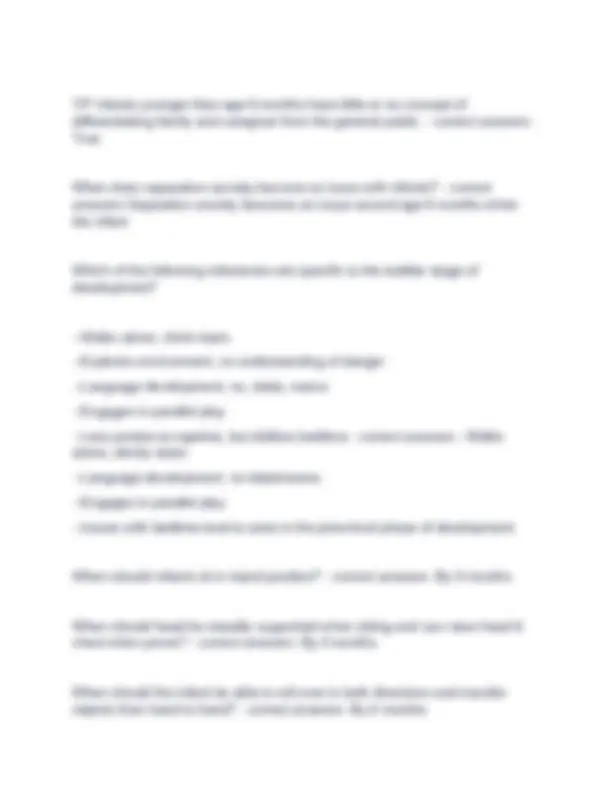
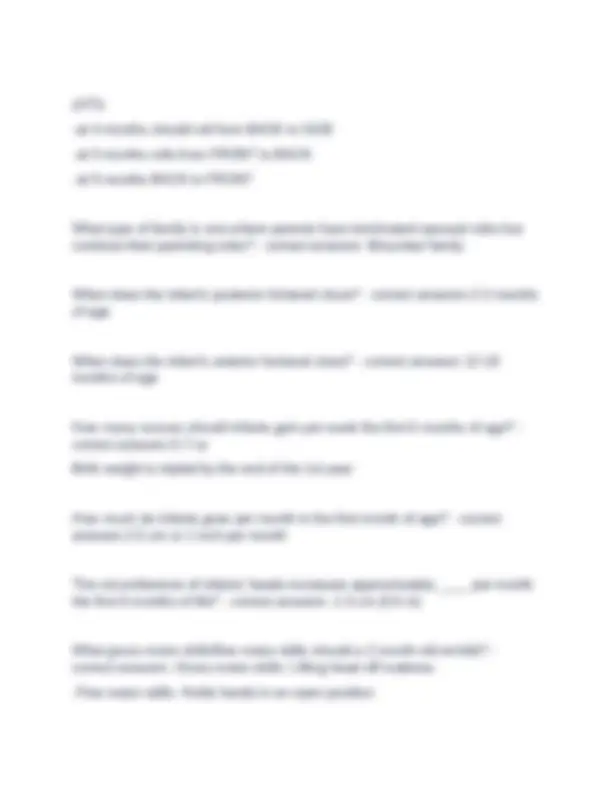
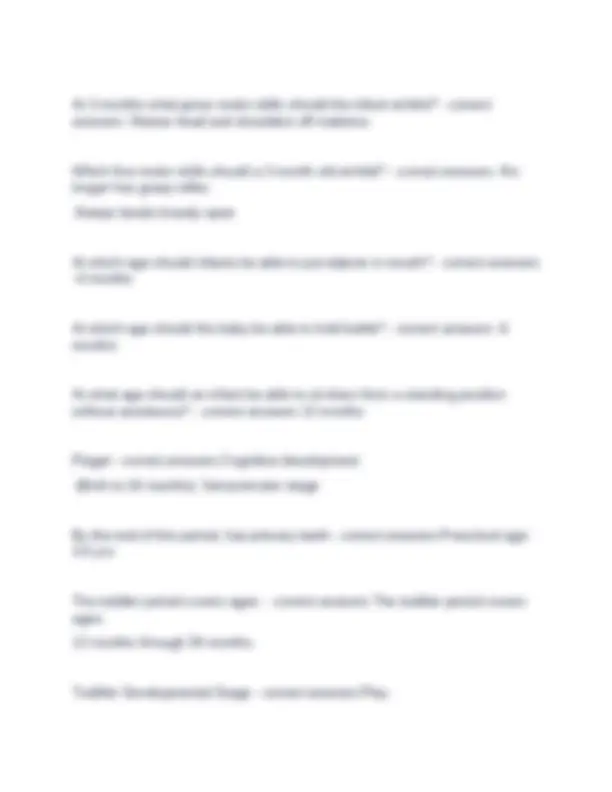
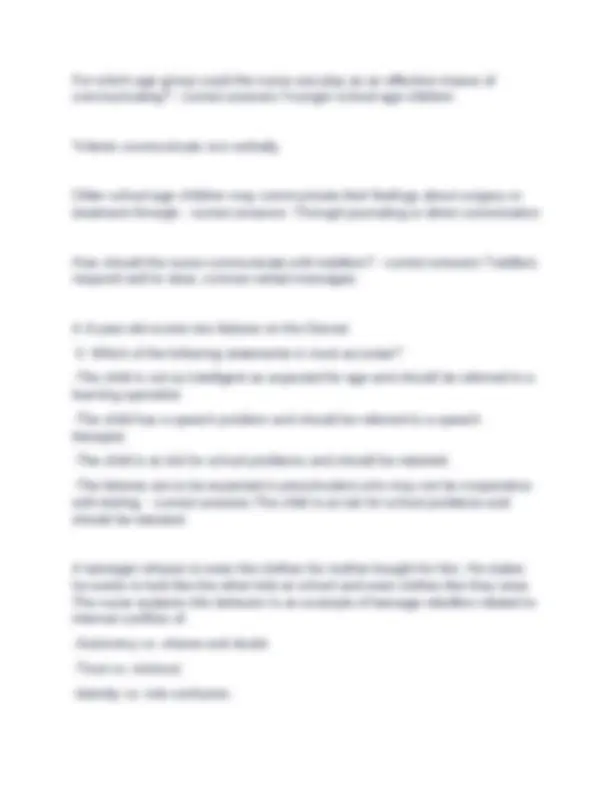
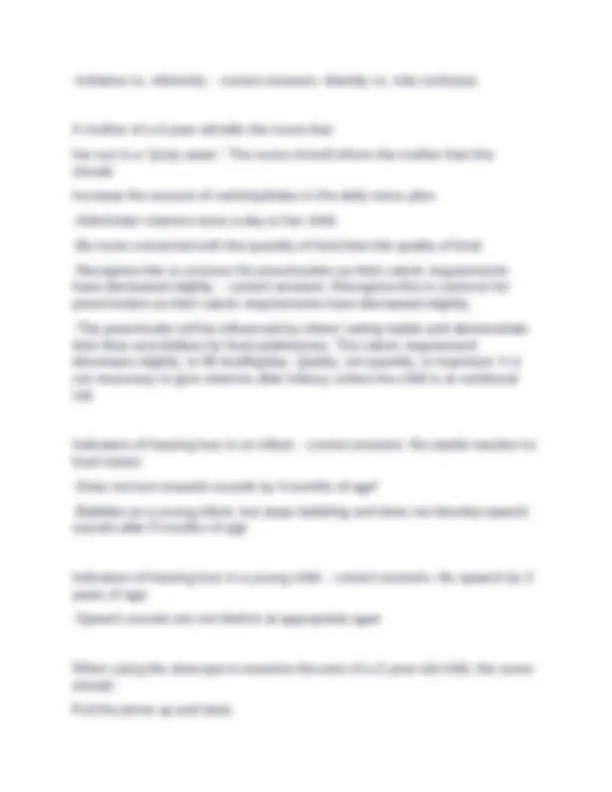
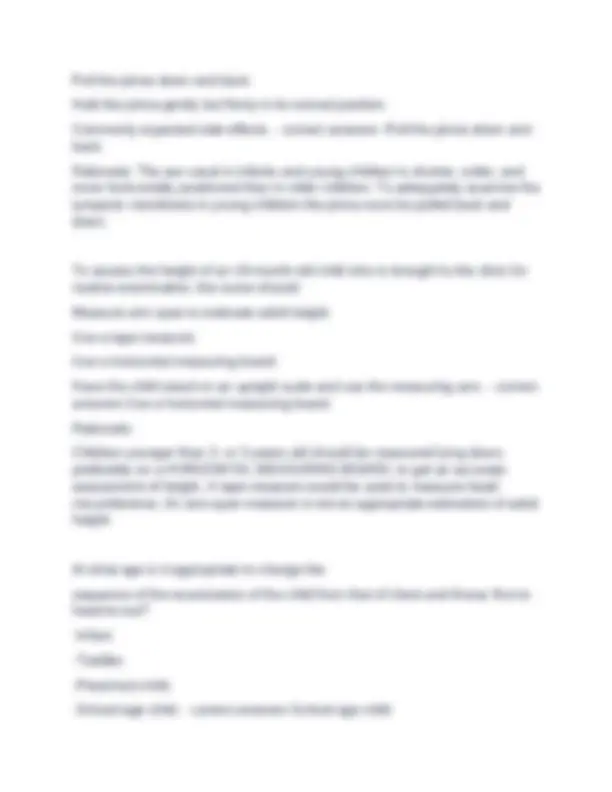
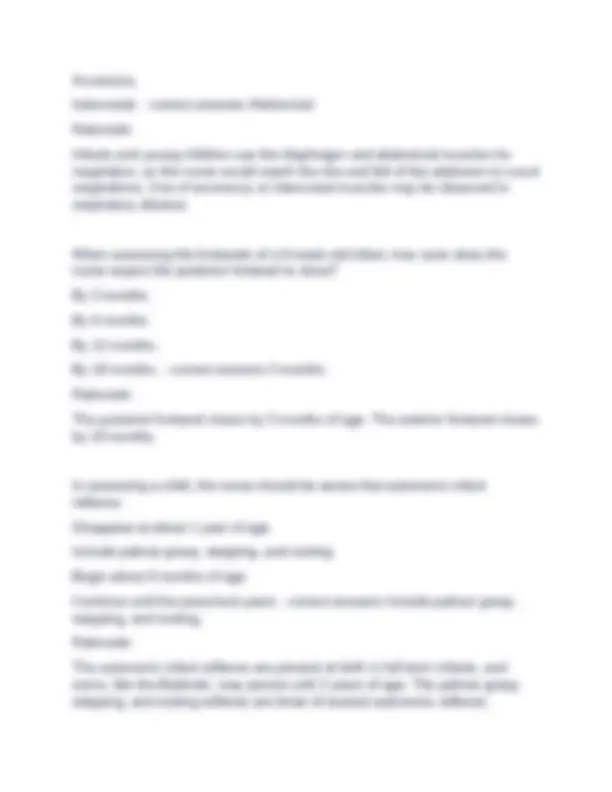
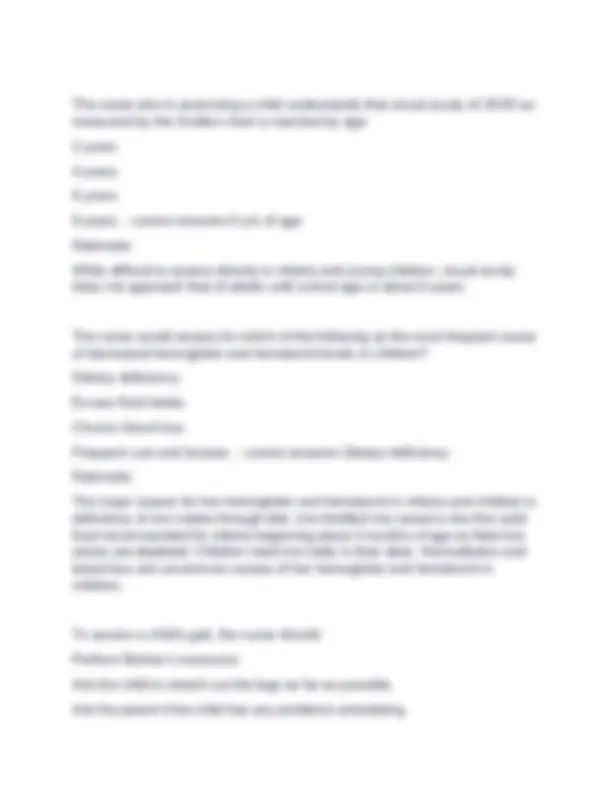
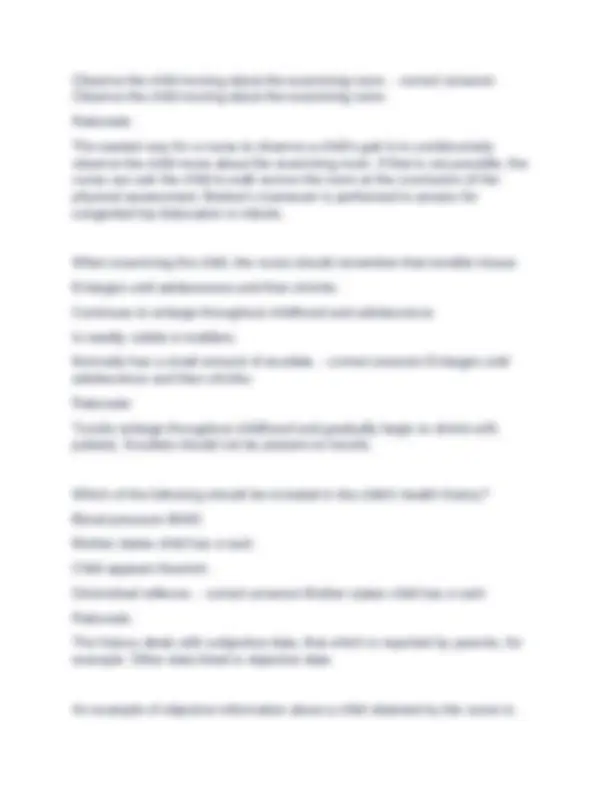
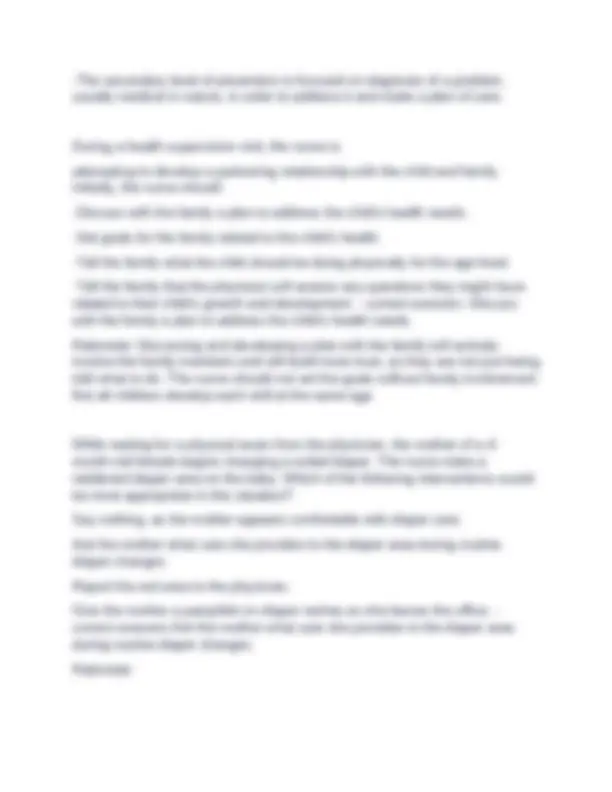
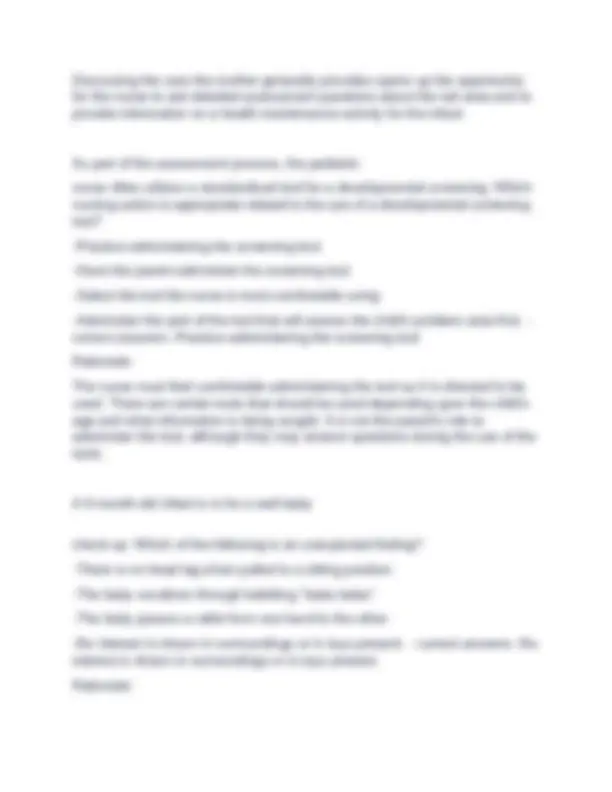
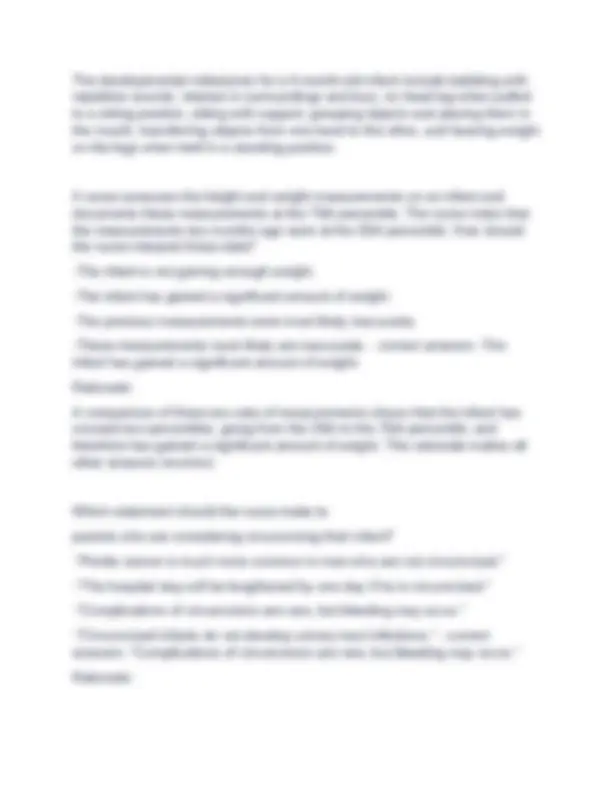
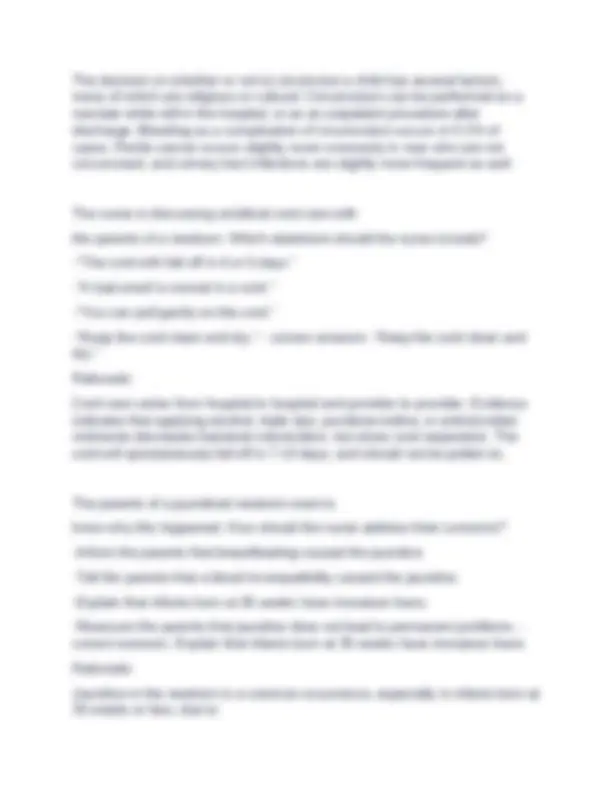
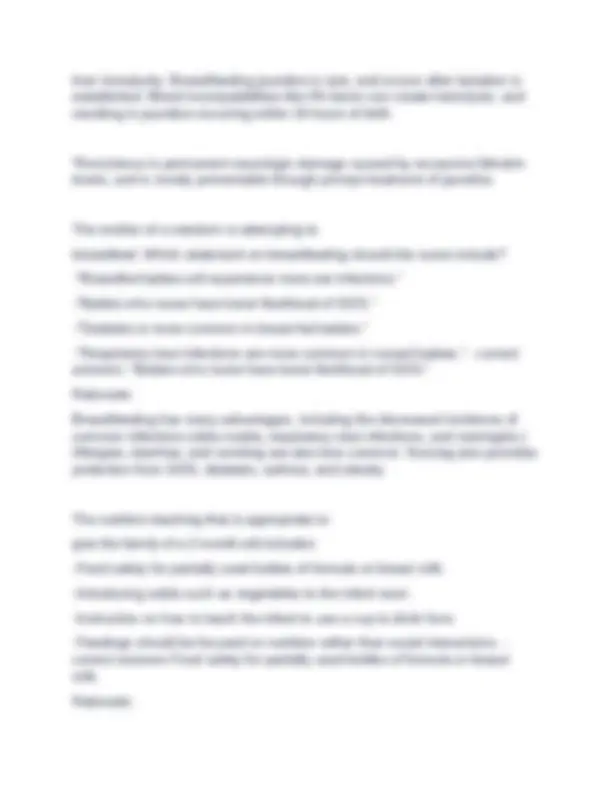
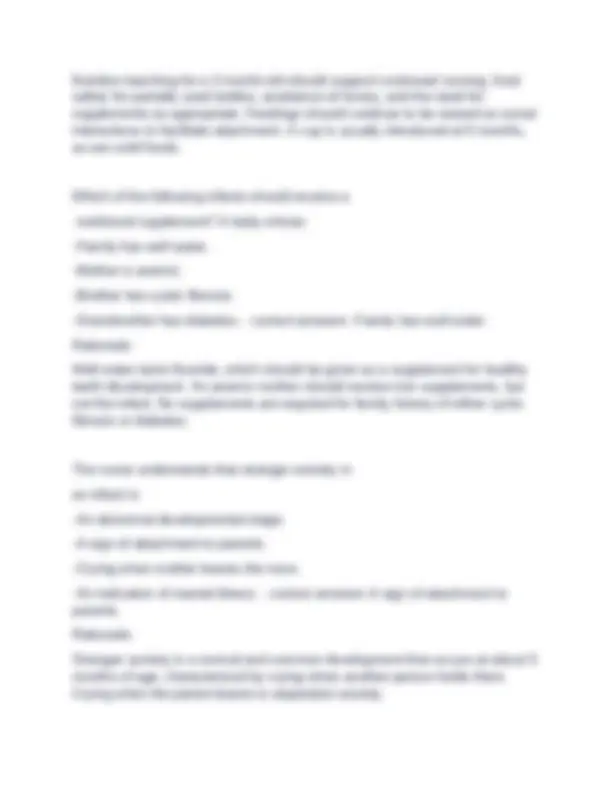
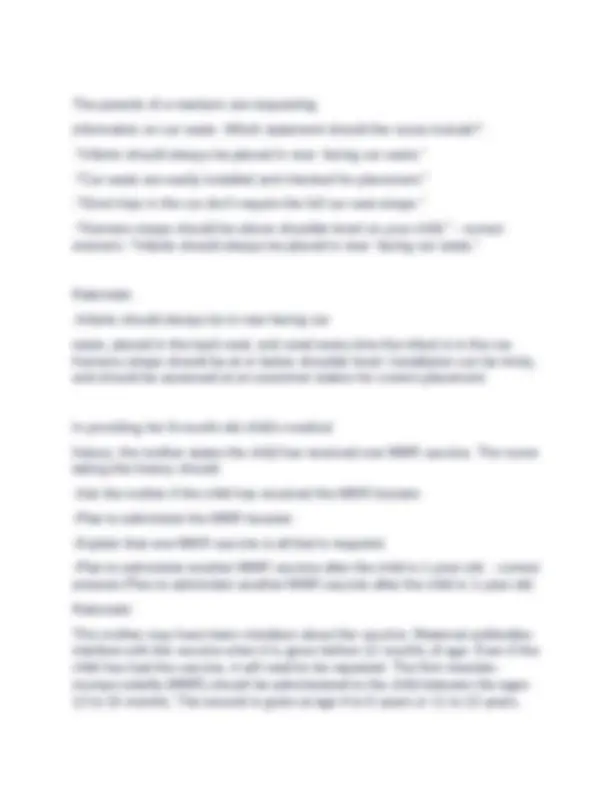
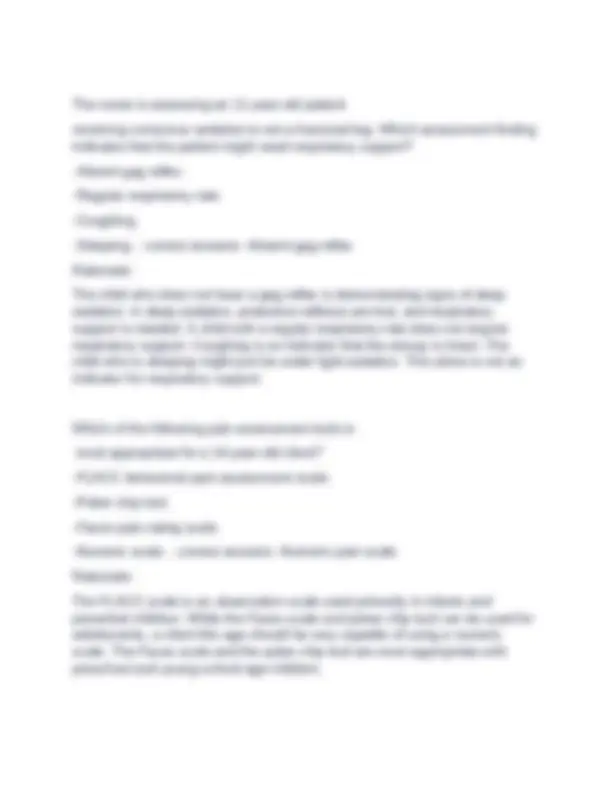
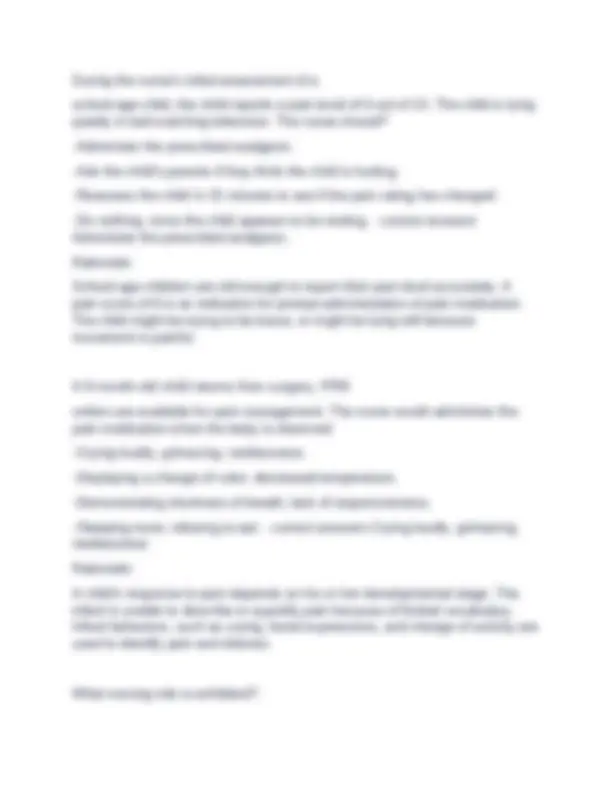
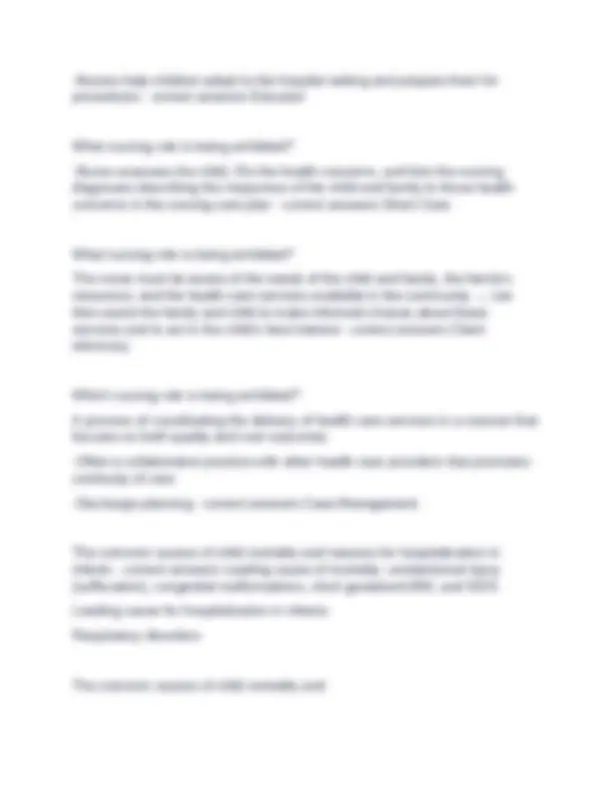
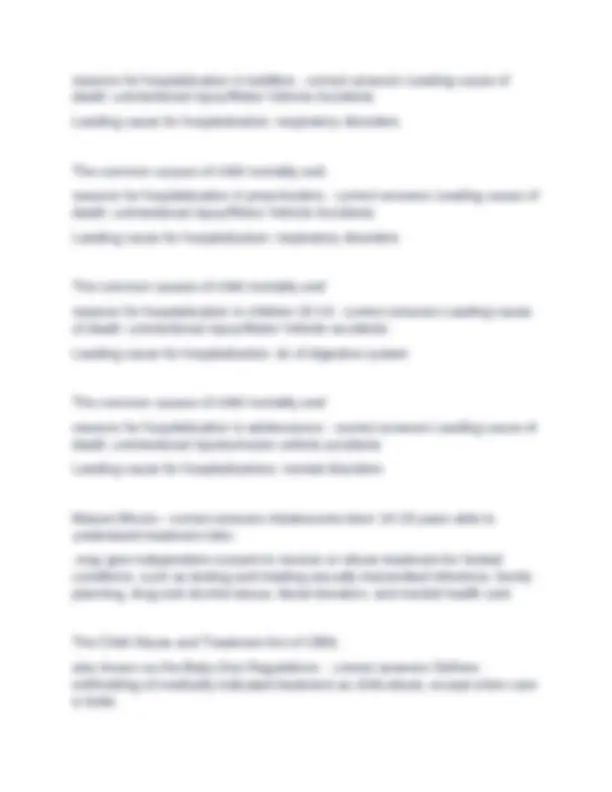
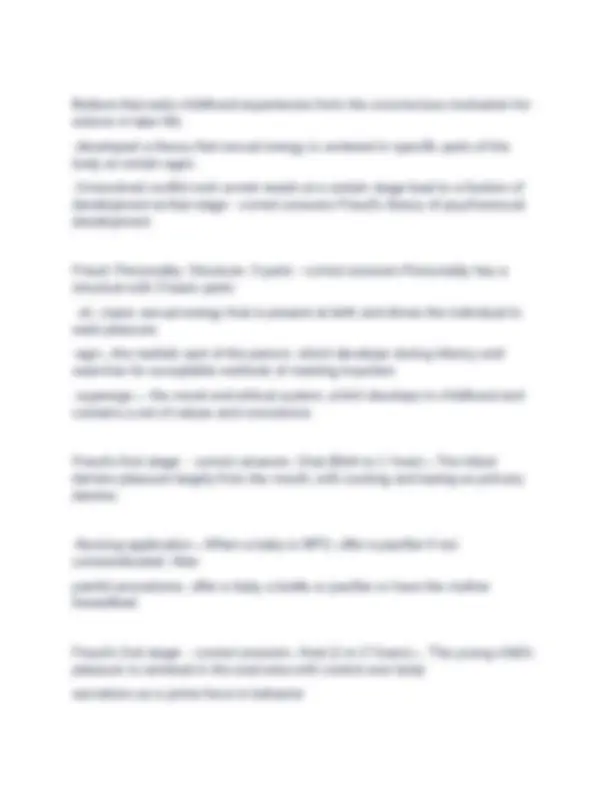
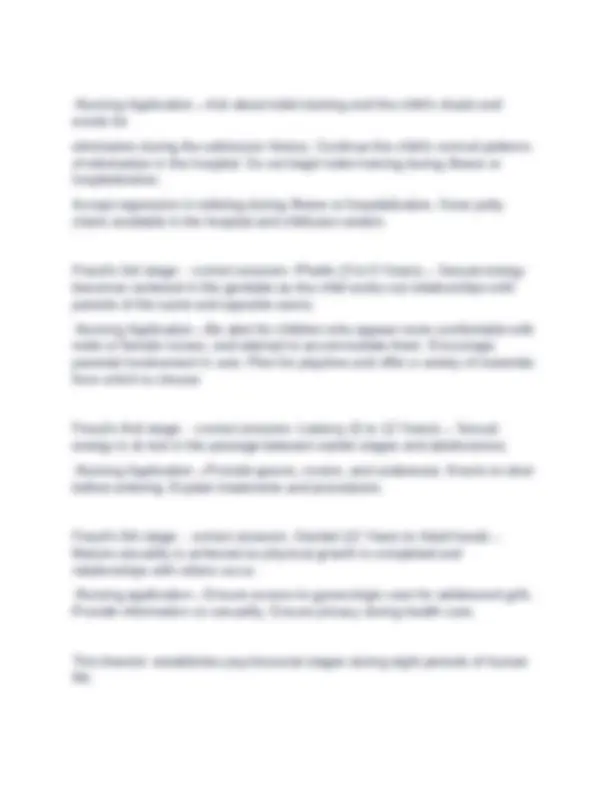
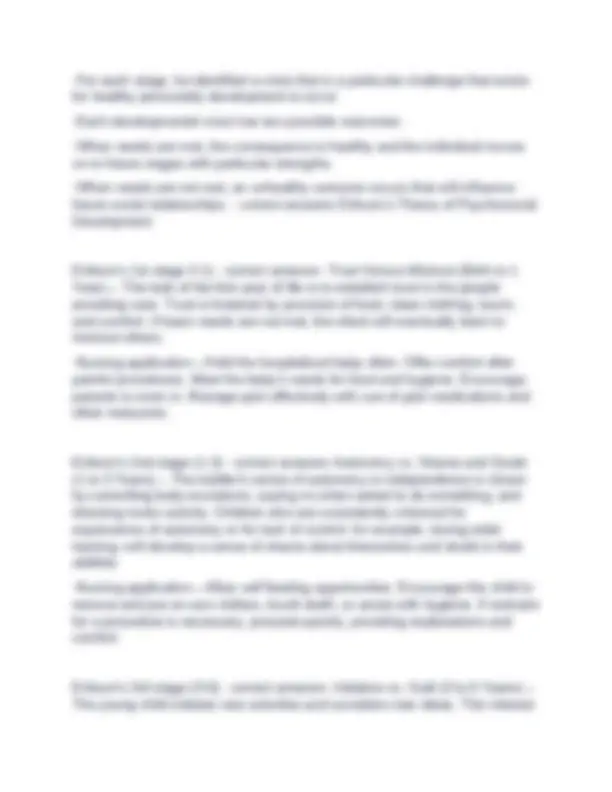
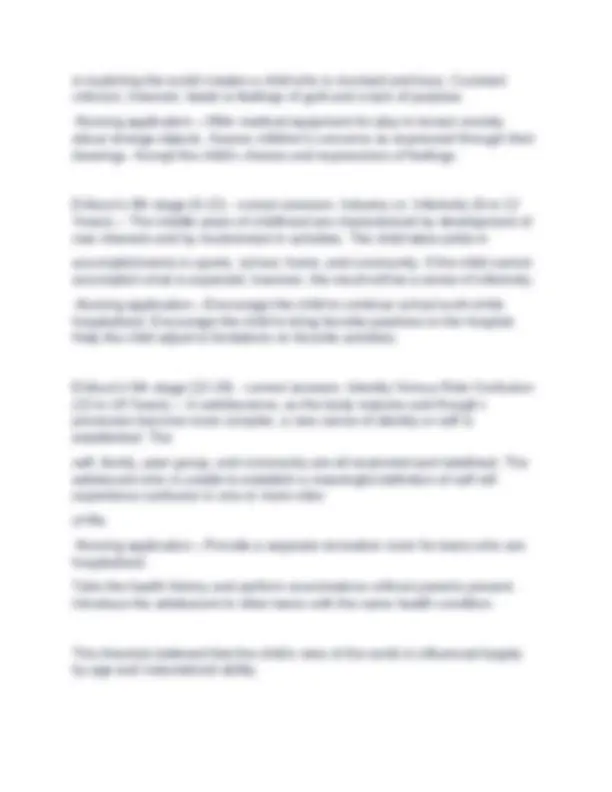
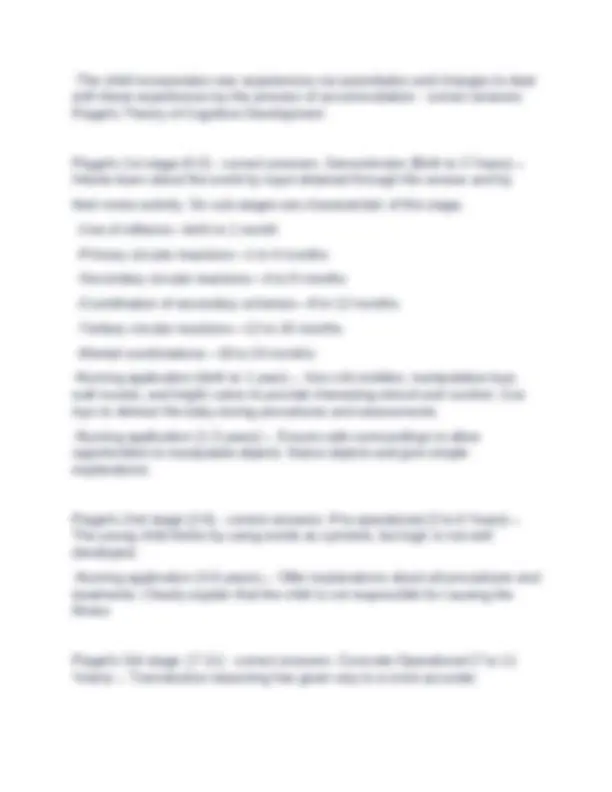
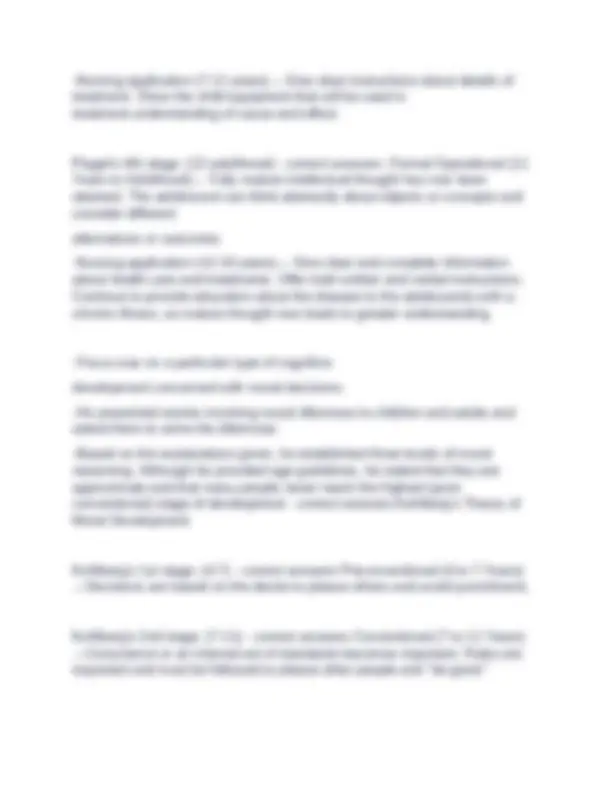
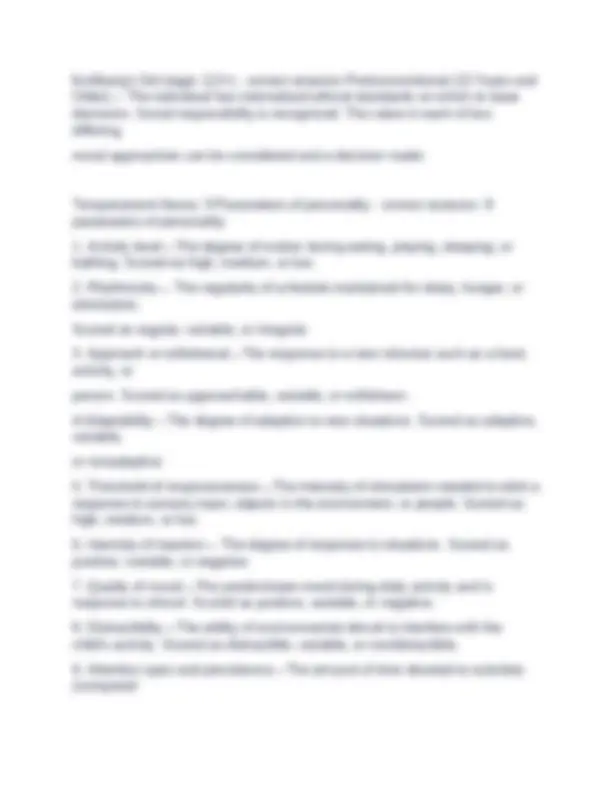
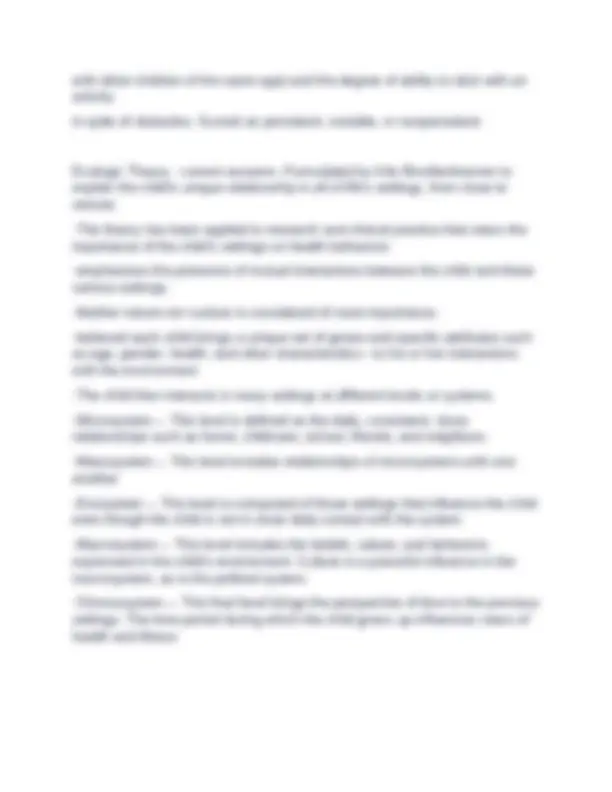
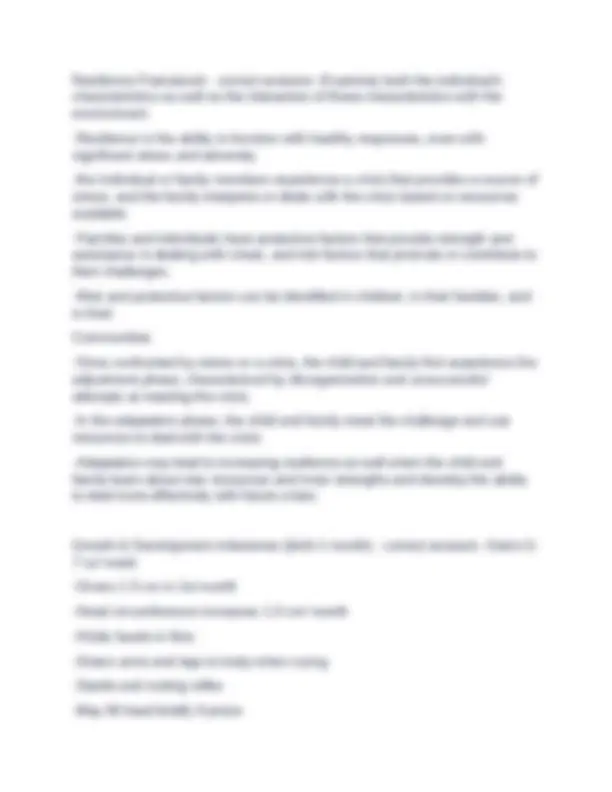
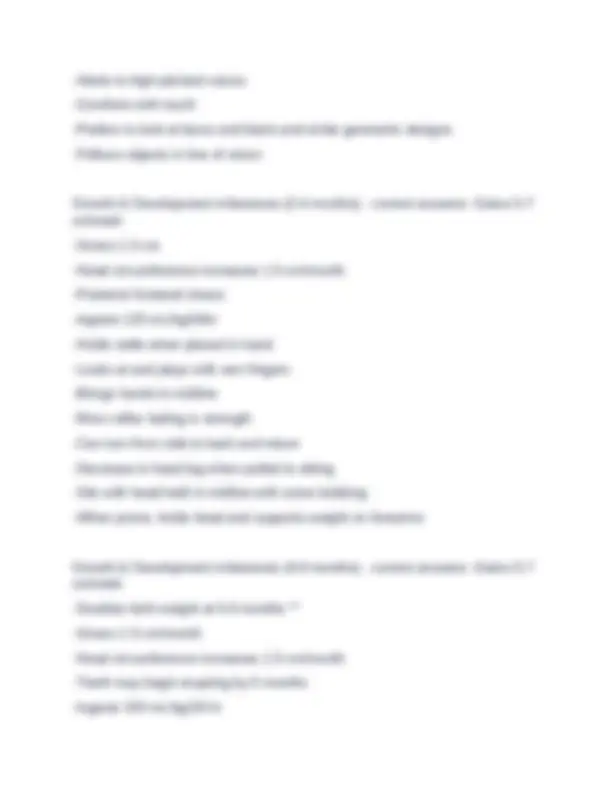
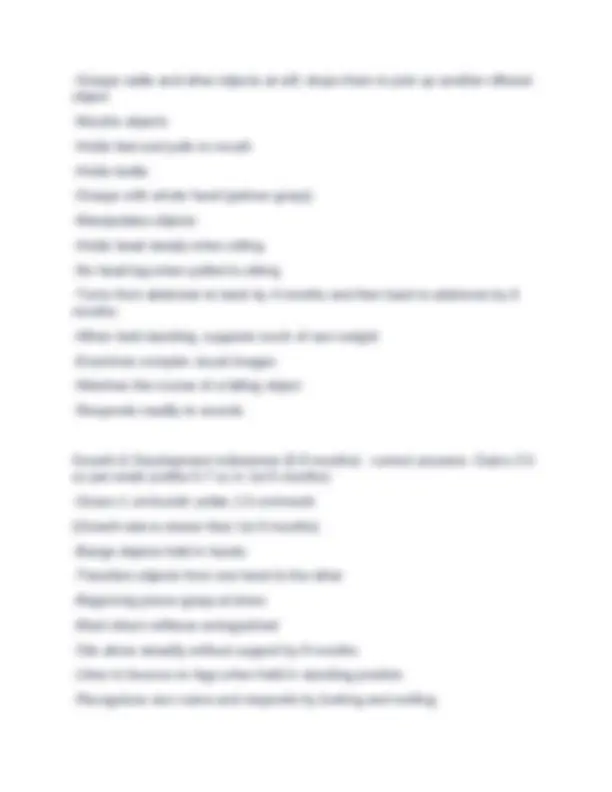
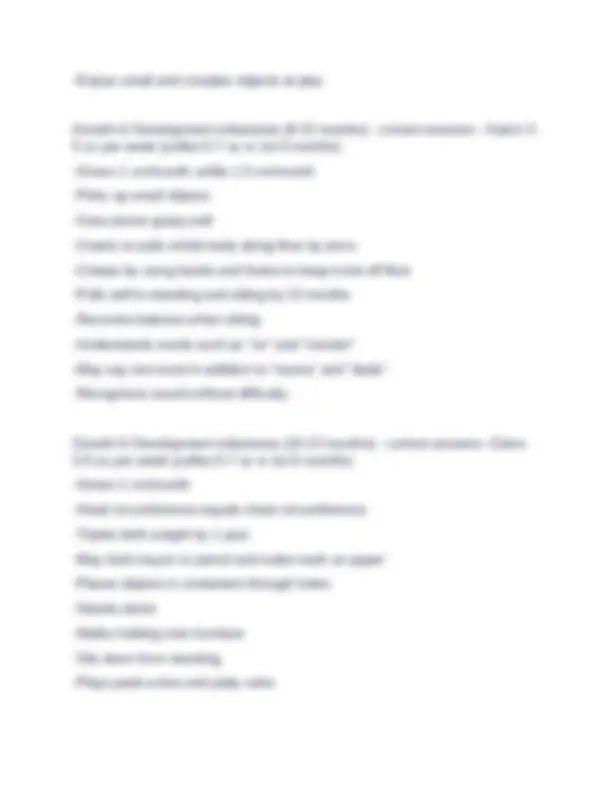
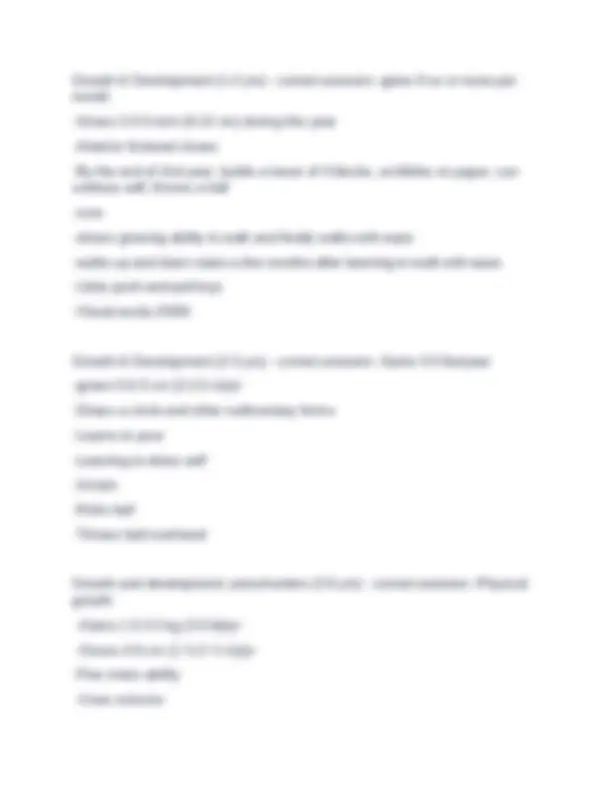
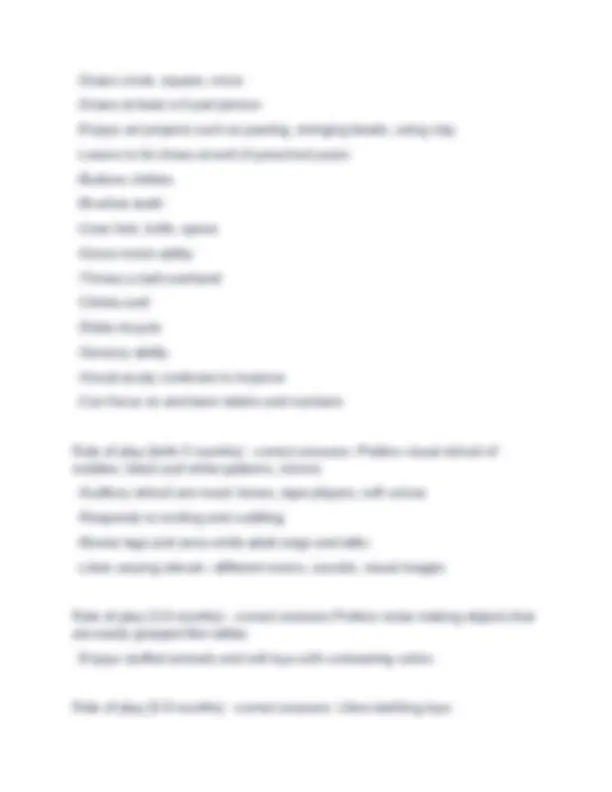
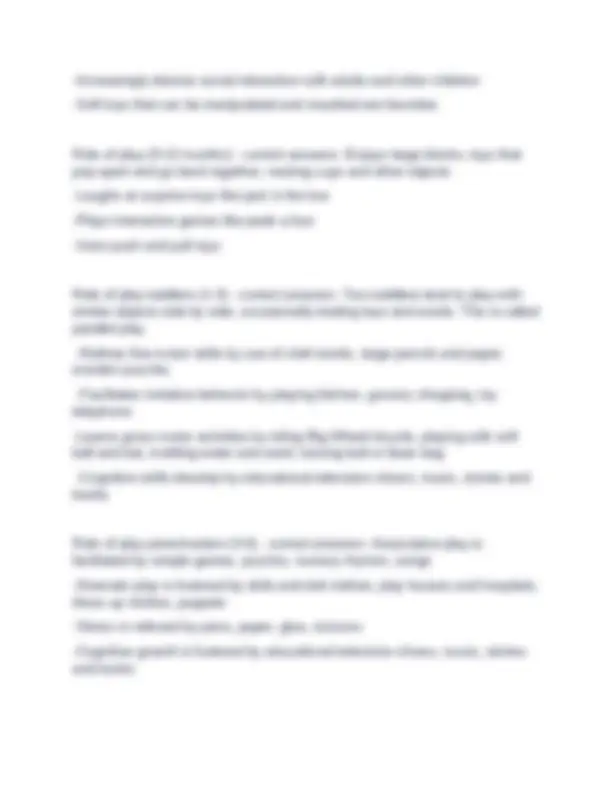
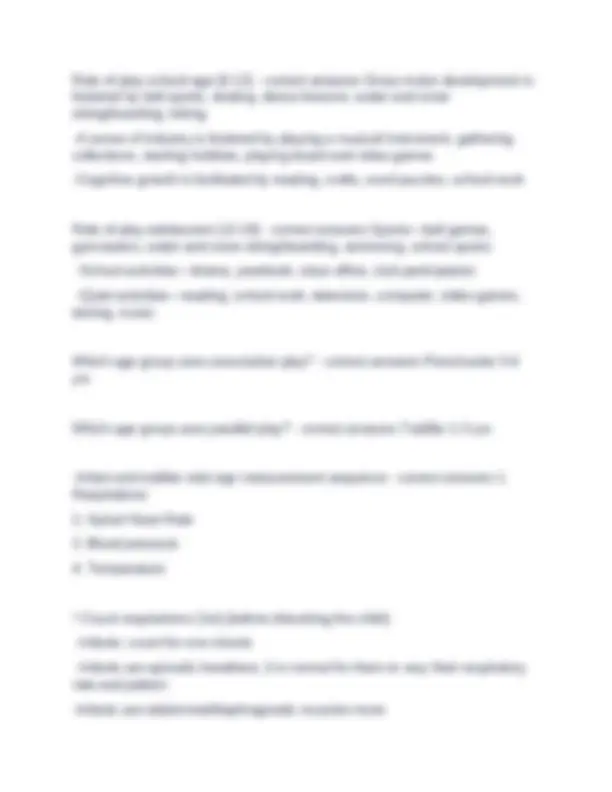
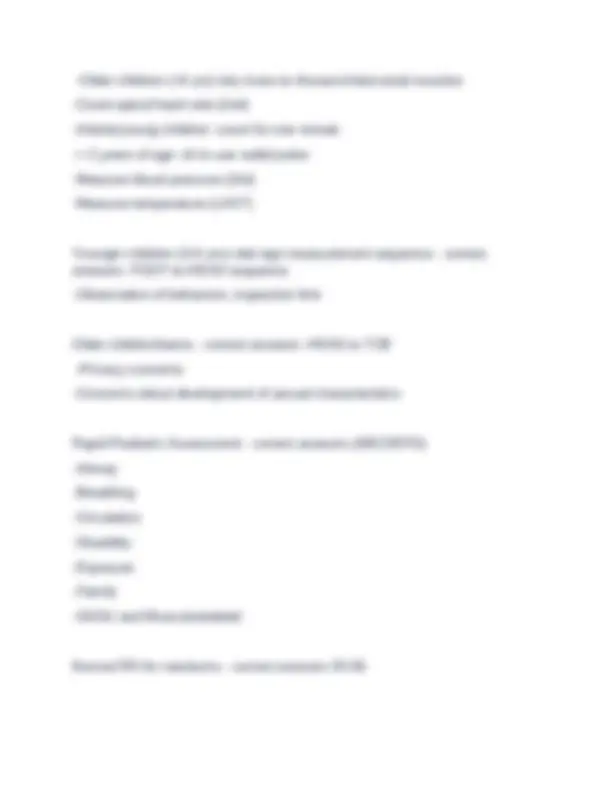
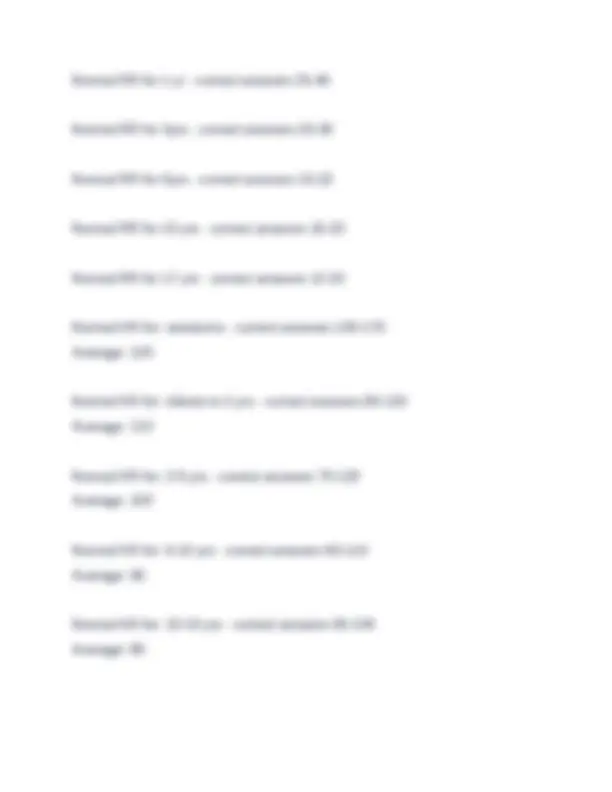
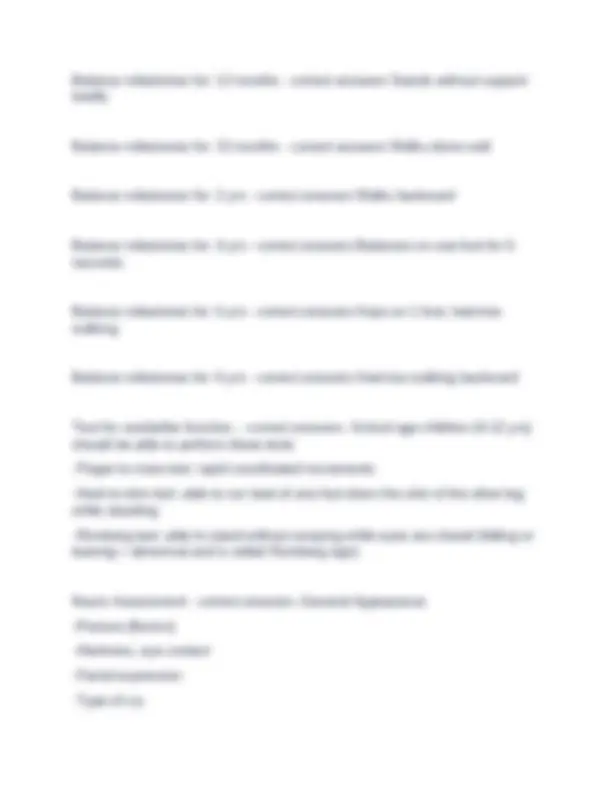
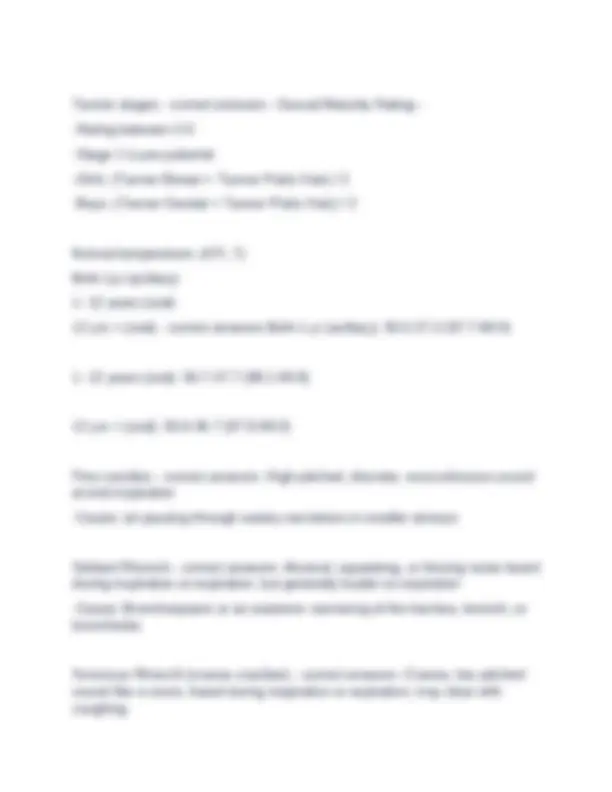
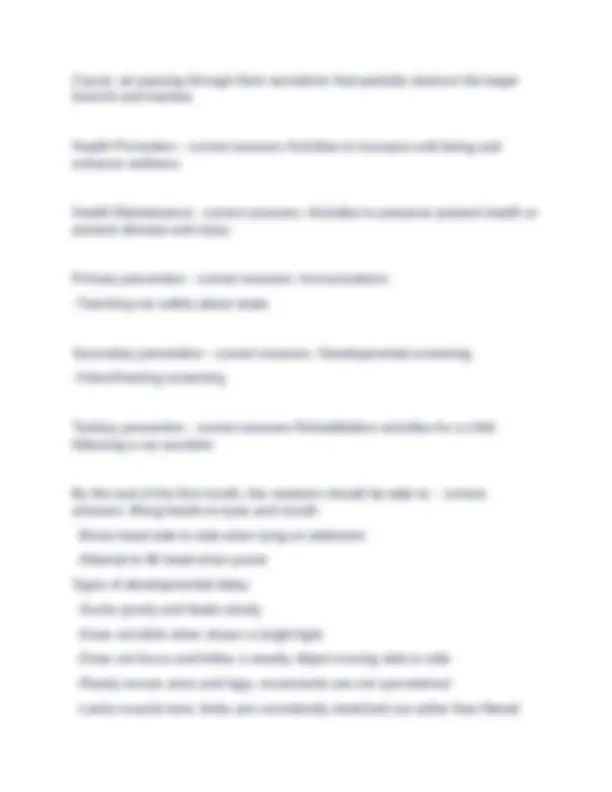
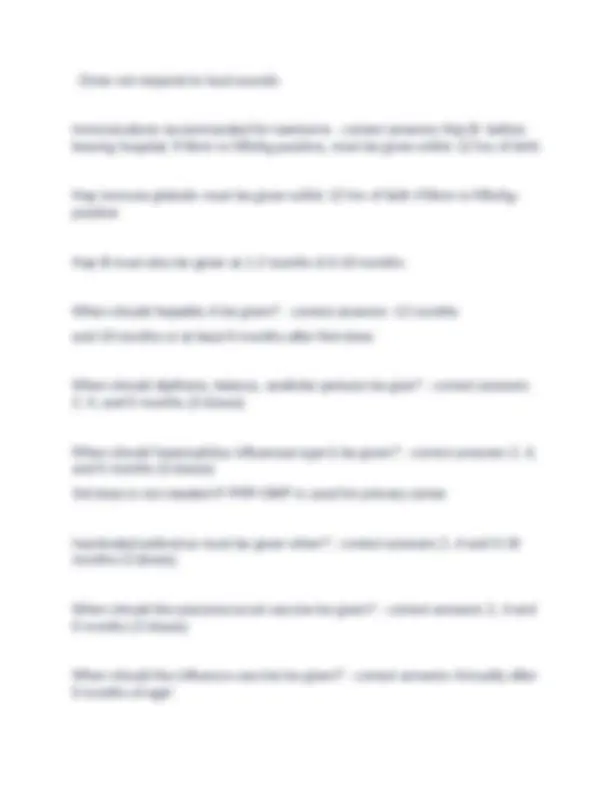
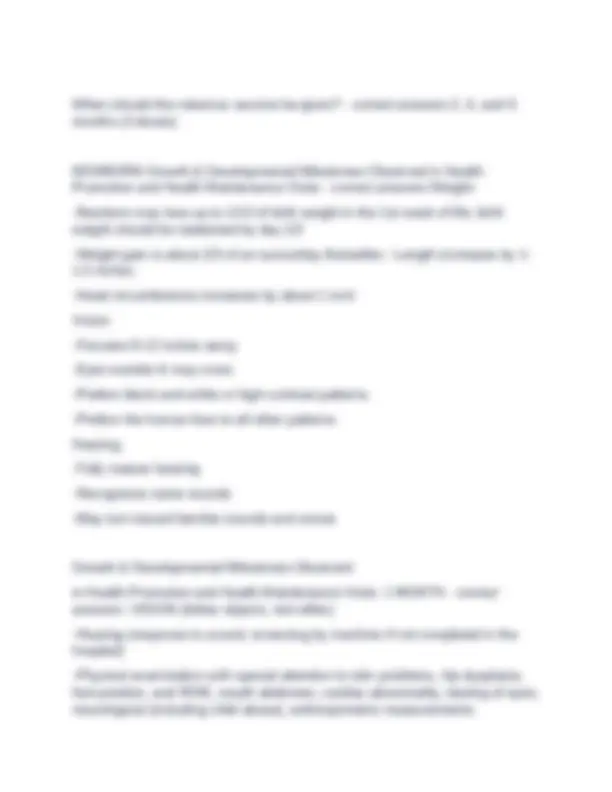
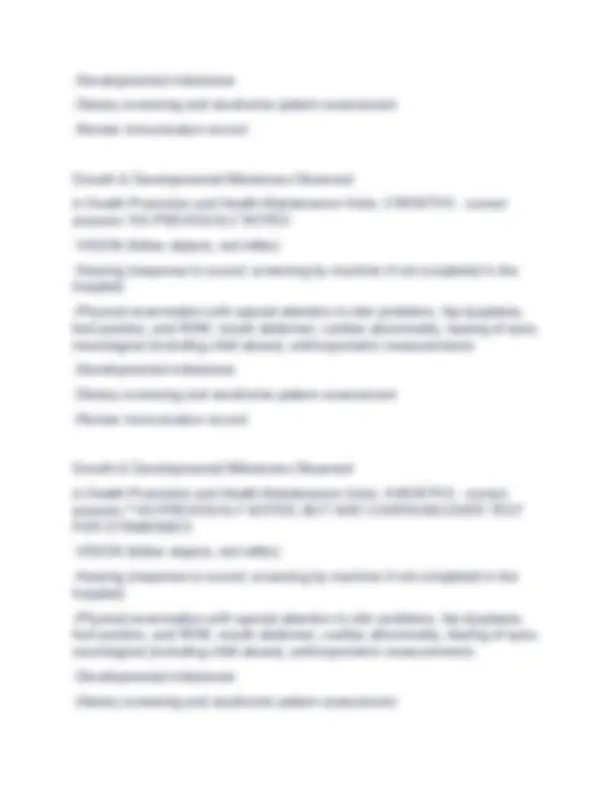
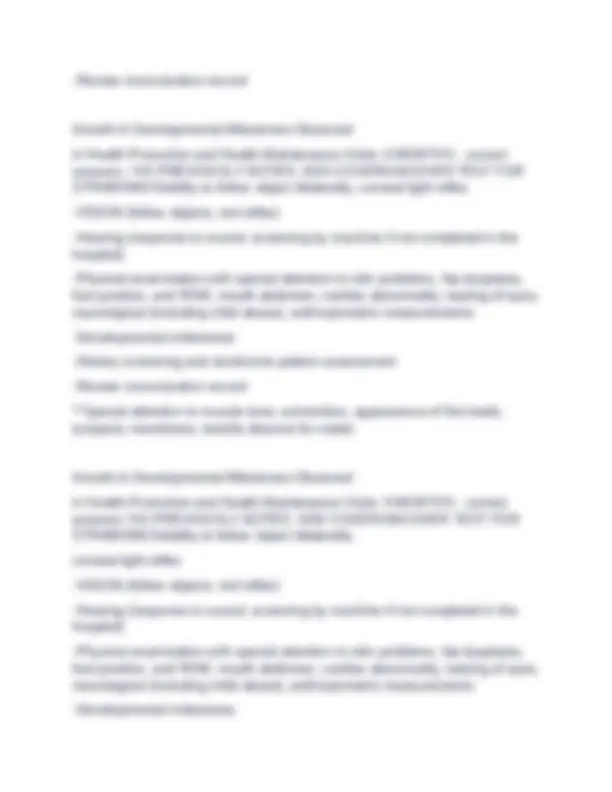
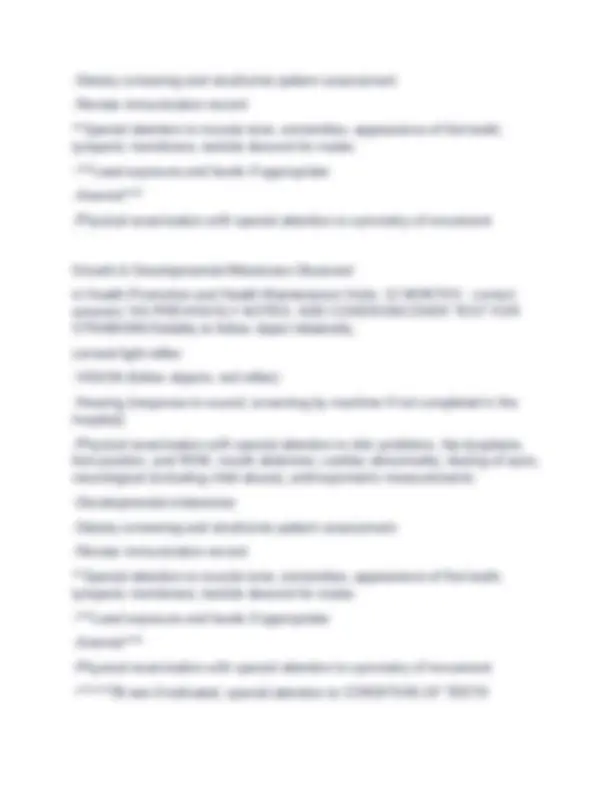
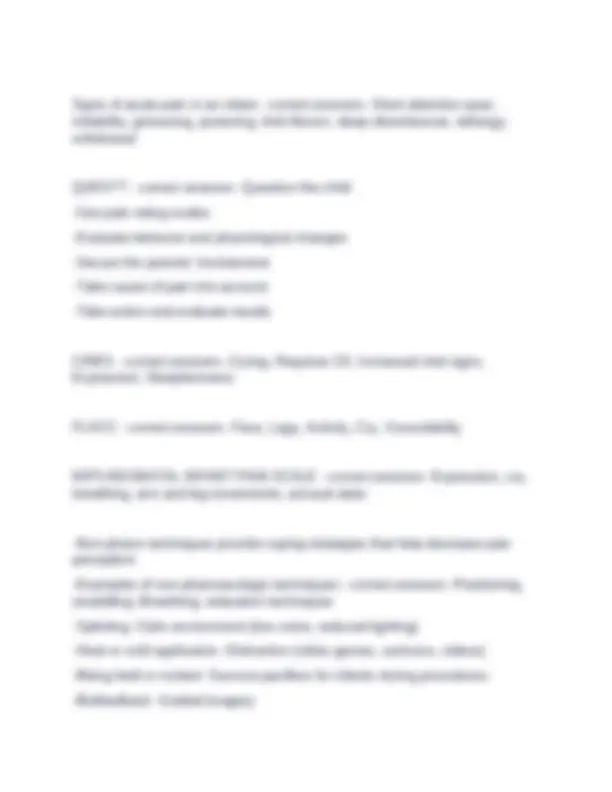
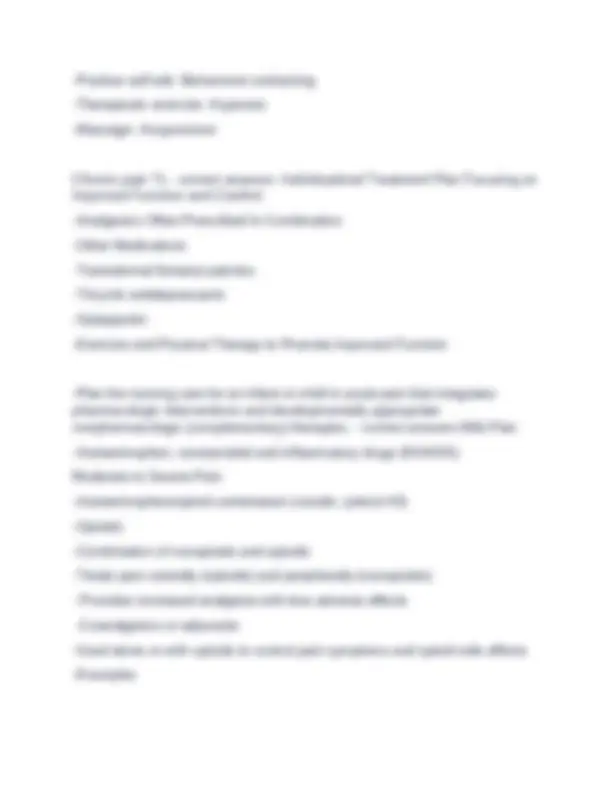
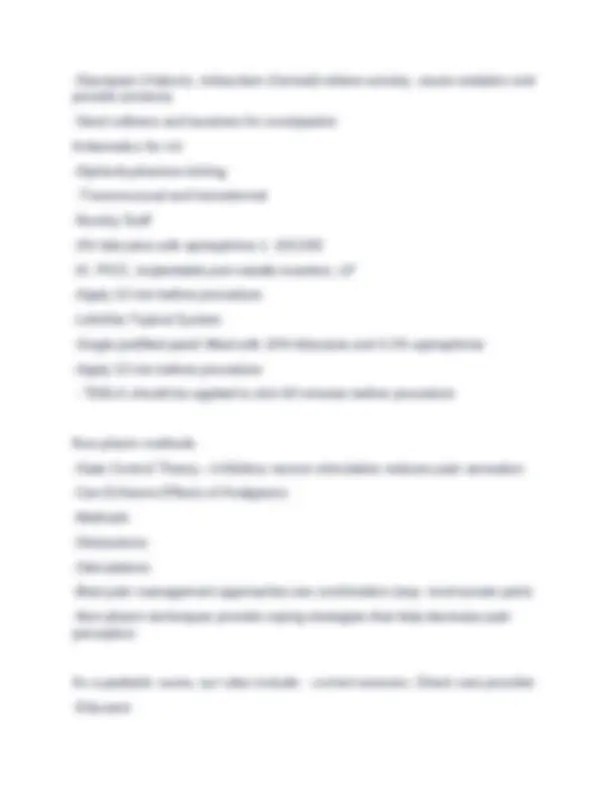
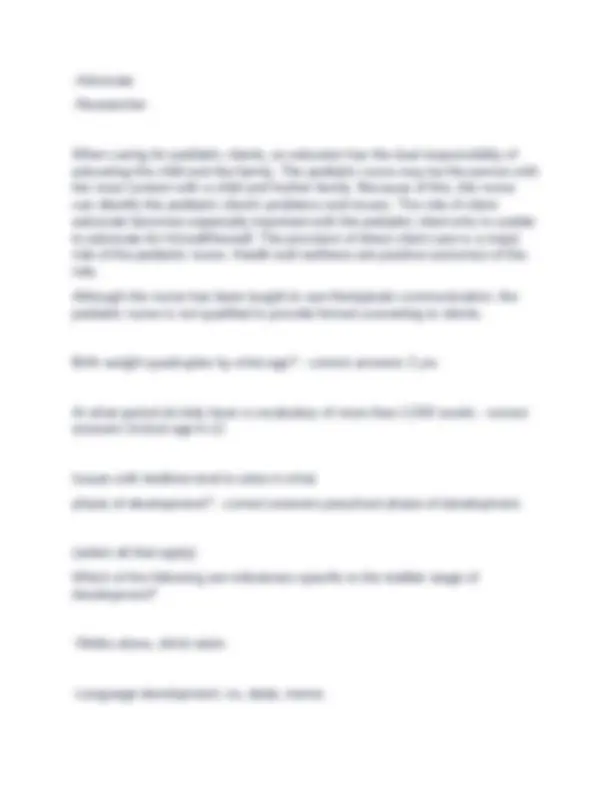
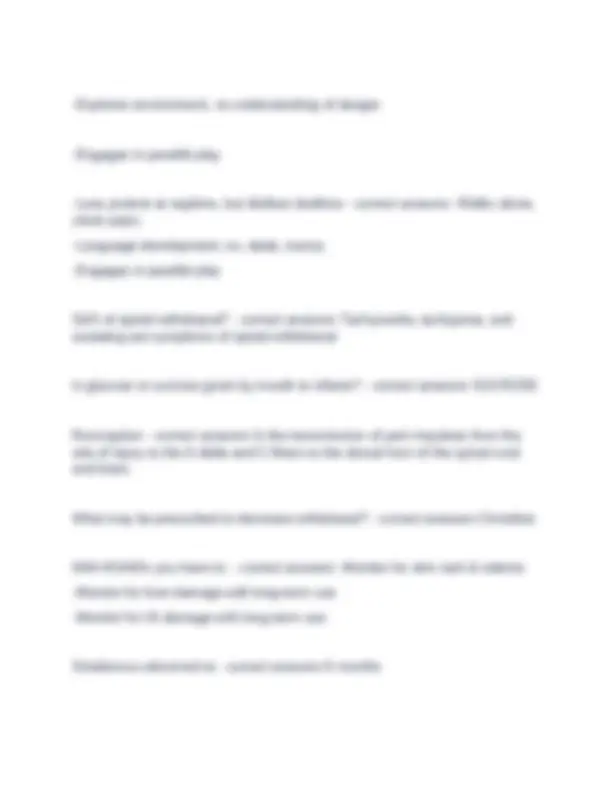
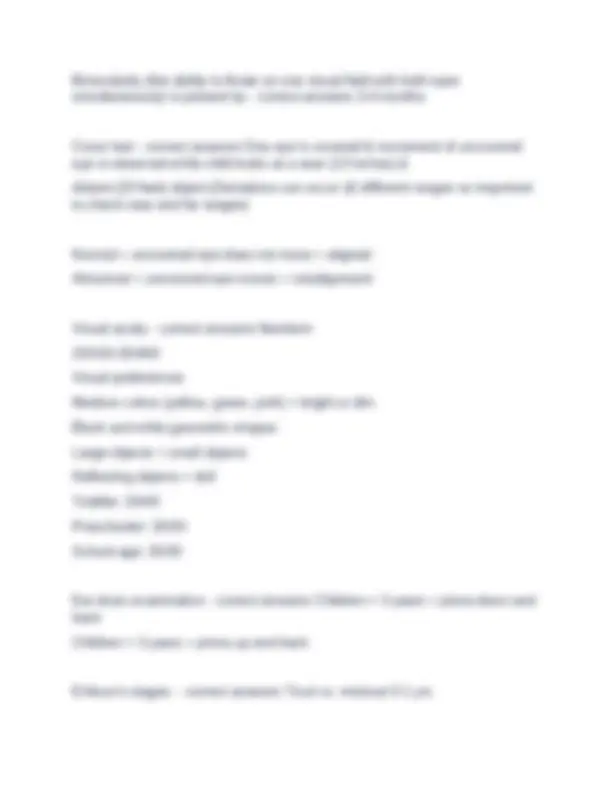
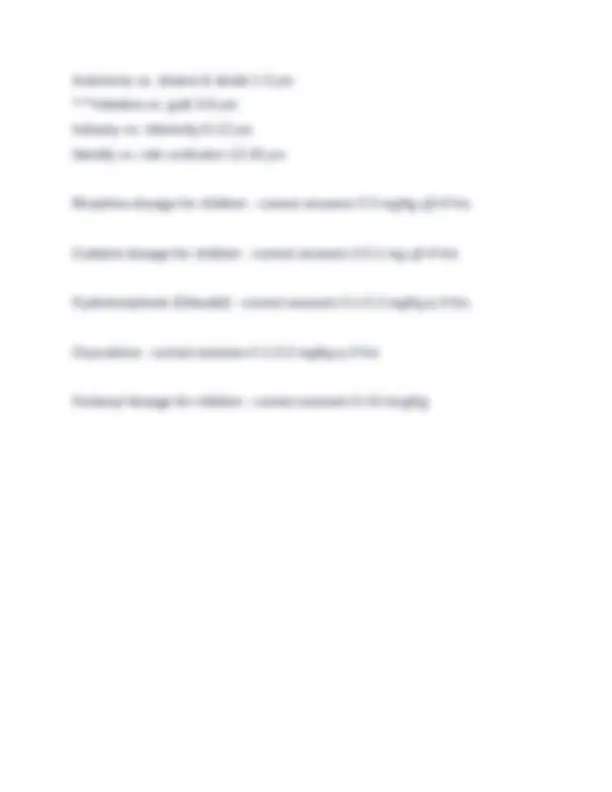


Study with the several resources on Docsity

Earn points by helping other students or get them with a premium plan


Prepare for your exams
Study with the several resources on Docsity

Earn points to download
Earn points by helping other students or get them with a premium plan
Community
Ask the community for help and clear up your study doubts
Discover the best universities in your country according to Docsity users
Free resources
Download our free guides on studying techniques, anxiety management strategies, and thesis advice from Docsity tutors
Peds Test #1 Question and answers correctly solved 2025
Typology: Exams
1 / 61

This page cannot be seen from the preview
Don't miss anything!






















































In order to administer a medication safely to a pediatric client, what drug information must the nurse be aware of that is not always essential when administering a medication to an adult client? Indicators of drug toxicity. Recommended dose per kg of body weight. Incompatibilities with other medications. Commonly expected side effects. - correct answers Recommended dose per kg of body weight. The nurse recognizes the need to update knowledge related to the most common cause of hospitalization in children. On which body system should continuing education focus? Gastrointestinal. Respiratory. Cardiac. Musculoskeletal. - correct answers Respiratory. The nurse is planning educational interventions to reduce the incidence of the number one cause of mortality in children ages 1-4. Recognizing the developmental needs of this age group, the nurse would focus the session on which topic? Seizure disorder management. Sudden infant death syndrome (SIDS) recognition. Child abuse prevention.
Unintentional injury awareness. - correct answers Unintentional injury awareness. A mother asks the pediatric nurse about what she should begin to feed her 6- month-old infant. The correct response is: Egg whites are the least allergenic food to be introduced into the baby's diet. Rice cereal is the first solid introduced that is least allergenic of the cereals. Formula is the only source of nutrition given for the first year. Fruits and vegetables are good sources of iron. - correct answers Rice cereal is the first solid introduced that is least allergenic of the cereals. Introduction of solid food is recommended at age 4 to 6 months, when the gastrointestinal system has matured sufficiently to handle complex nutrients. The suck reflex and tongue-thrust reflex diminish at 4 months of age. Rice cereal is the first solid food because it is a rich source of iron and rarely induces allergic reactions. **Fruits and vegetables, good sources of vitamins and fiber, are introduced after cereal, one at a time to determine allergic reactions. Egg whites are highly allergenic. Birth weight doubles by which month? - correct answers 6 months Birth weight triples by? - correct answers End of 12 months (1st year) T/F Infants are unable to digest the large molecules of cow's milk. - correct answers True When are solids begun? - correct answers Solids are begun around age 6 months w/ pureed forms of food
-at 4 months should roll from BACK to SIDE -at 5 months rolls from FRONT to BACK -at 6 months BACK to FRONT What type of family is one where parents have terminated spousal roles but continue their parenting roles? - correct answers -Binuclear family When does the infant's posterior fontanel close? - correct answers 2-3 months of age When does the infant's anterior fontanel close? - correct answers 12- months of age How many ounces should infants gain per week the first 6 months of age? - correct answers 5-7 oz Birth weight is tripled by the end of the 1st year How much do infants grow per month in the first month of age? - correct answers 2.5 cm or 1 inch per month The circumference of infants' heads increases approximately ____ per month the first 6 months of life? - correct answers -1.5 cm (0.6 in) What gross motor skills/fine motor skills should a 2 month old exhibit? - correct answers -Gross motor skills: Lifting head off mattress -Fine motor skills: Holds hands in an open position
At 3 months what gross motor skills should the infant exhibit? - correct answers -Raises head and shoulders off mattress Which fine motor skills should a 3 month old exhibit? - correct answers -No longer has grasp reflex -Keeps hands loosely open At which age should infants be able to put objects in mouth? - correct answers -4 months At which age should the baby be able to hold bottle? - correct answers - months At what age should an infant be able to sit down from a standing position without assistance? - correct answers 12 months Piaget - correct answers Cognitive development (Birth to 24 months): Sensorimotor stage By the end of this period, has primary teeth - correct answers Preschool age: 3-6 yrs The toddler period covers ages: - correct answers The toddler period covers ages: 12 months through 36 months. Toddler Developmental Stage - correct answers Play
Developmental Stage: Preschool-Age - correct answers MNL says 3-5 years Preschool Age Play - correct answers Associative play Plays in groups Rules may or may not be defined Preschool Age Children Nutrition - correct answers Develops strong preferences Prefers to eat the same food at each meal Can feed self Growth slows By the end of this period, has all primary teeth Preschool Age Development - correct answers Climbs stairs, jumps, and runs with increasing skill Increased mobility Language development: Egocentric, knows colors Is developing socialization skills, differentiates gender of peers and/or siblings Less protest related to naptime but dislikes bedtime Magical thinking Prefers routine When does growth plateau? - correct answers School age 6-12 yrs Stranger anxiety starts at what age? - correct answers -6 months
For which age group could the nurse use play as an effective means of communicating? - correct answers Younger school-age children *Infants communicate non-verbally Older school-age children may communicate their feelings about surgery or treatment through - correct answers -Through journaling or direct conversation How should the nurse communicate with toddlers? - correct answers Toddlers respond well to clear, concise verbal messages. A 4-year-old scores two failures on the Denver II. Which of the following statements is most accurate? -The child is not as intelligent as expected for age and should be referred to a learning specialist. -The child has a speech problem and should be referred to a speech therapist. -The child is at risk for school problems and should be retested. -The failures are to be expected in preschoolers who may not be cooperative with testing. - correct answers The child is at risk for school problems and should be retested. A teenager refuses to wear the clothes his mother bought for him. He states he wants to look like the other kids at school and wear clothes like they wear. The nurse explains this behavior is an example of teenage rebellion related to internal conflicts of: -Autonomy vs. shame and doubt. -Trust vs. mistrust. -Identity vs. role confusion.
Pull the pinna down and back. Hold the pinna gently but firmly in its normal position. Commonly expected side effects. - correct answers -Pull the pinna down and back. Rationale: The ear canal in infants and young children is shorter, wider, and more horizontally positioned than in older children. To adequately examine the tympanic membrane in young children the pinna must be pulled back and down. To assess the height of an 18-month-old child who is brought to the clinic for routine examination, the nurse should: Measure arm span to estimate adult height. Use a tape measure. Use a horizontal measuring board. Have the child stand on an upright scale and use the measuring arm. - correct answers Use a horizontal measuring board. Rationale: Children younger than 2- or 3-years-old should be measured lying down, preferably on a HORIZONTAL MEASURING BOARD, to get an accurate assessment of height. A tape measure would be used to measure head circumference. An arm-span measure is not an appropriate estimation of adult height. At what age is it appropriate to change the sequence of the examination of the child from that of chest and thorax first to head-to-toe? -Infant. -Toddler. -Preschool child. -School-age child. - correct answers School-age child
Rationale: The school-age years are the first time a child is able to reliably cooperate with the examiner and not squirm, talk, or otherwise interrupt the exam. In younger children, it is essential to begin with the chest and thorax because the child needs to be quiet and at rest. When assessing a preschool age child's mouth, how many deciduous teeth should the nurse expect to find? Up to 10. 11 to 15. 16 to 20. Up to 32. - correct answers 16- Rationale: Children get the first of 20 deciduous teeth between the ages of 6 months and 5 years.. All 32 permanent teeth are usually erupted in late adolescence. When do permanent teeth begin to erupt? - correct answers Permanent teeth begin to erupt about he age of 6 as deciduous teeth fall out Screening for strabismus (crossed eyes) and amblyopia (reduced vision in one or both eyes) should be part of the physical assessment of which children? -All children under 18. -Infants. -Preschool children. -School-age children. - correct answers Pre-school children Rationale:
Accessory. Intercostal. - correct answers Abdominal Rationale: Infants and young children use the diaphragm and abdominal muscles for respiration, so the nurse would watch the rise and fall of the abdomen to count respirations. Use of accessory or intercostal muscles may be observed in respiratory distress. When assessing the fontanels of a 6-week-old infant, how soon does the nurse expect the posterior fontanel to close? By 3 months. By 6 months. By 12 months. By 18 months. - correct answers 3 months Rationale: The posterior fontanel closes by 3 months of age. The anterior fontanel closes by 18 months. In assessing a child, the nurse should be aware that autonomic infant reflexes: Disappear at about 1 year of age. Include palmar grasp, stepping, and rooting. Begin about 6 months of age. Continue until the preschool years - correct answers Include palmar grasp, stepping, and rooting. Rationale: The autonomic infant reflexes are present at birth in full-term infants, and some, like the Babinski, may persist until 2 years of age. The palmar grasp, stepping, and rooting reflexes are three of several autonomic reflexes.
The nurse who is examining a child understands that visual acuity of 20/20 as measured by the Snellen chart is reached by age: 2 years. 4 years. 6 years. 8 years. - correct answers 6 yrs of age Rationale: While difficult to assess directly in infants and young children, visual acuity does not approach that of adults until school age or about 6 years. The nurse would assess for which of the following as the most frequent cause of decreased hemoglobin and hematocrit levels in children? Dietary deficiency. Excess fluid intake. Chronic blood loss. Frequent cuts and bruises. - correct answers Dietary deficiency Rationale: The major reason for low hemoglobin and hematocrit in infants and children is deficiency of iron intake through diet. Iron-fortified rice cereal is the first solid food recommended for infants beginning about 4 months of age as fetal iron stores are depleted. Children need iron daily in their diets. Hemodilution and blood loss are uncommon causes of low hemoglobin and hematocrit in children. To assess a child's gait, the nurse should: Perform Barlow's maneuver. Ask the child to stretch out the legs as far as possible. Ask the parent if the child has any problems ambulating.
Allergy to peanuts. Uses inhaler once a day for asthma. Two-inch scar on right lower leg. Appendectomy 6 months ago. - correct answers Two-inch scar on right lower leg. Rationale: Objective data is that which the nurse obtains through physical assessment or diagnostic studies. The presence of a scar is objective data. Other selections listed are part of the health history and therefore are subjective data. When observing an 18-month-old child, the nurse notes a rounded belly, sway back, bowlegs, and slightly large head. The nursing conclusion is that: The child appears to be a normal toddler. The child is likely developmentally delayed. The child may be malnourished, especially with respect to calcium. The enlarged head is of great concern and requires a thorough neurological exam. - correct answers The child appears to be a normal toddler. Rationale: The typical toddler has lordosis and a protruding belly. The head still appears somewhat large in proportion to the rest of the body. Because these are normal findings, there is no need to be concerned about developmental delays, malnutrition, or neurological problems. Regardless of the child's age, which assessment technique is always used first? Palpation. Percussion. Auscultation. Inspection. - correct answers Inspection
A pediatric healthcare nurse visit should include: -Family-centered care and partnership for primary care provision. -Different nurses for each visit to gather different perspectives. -Instruction on how to raise children according to U.S. norms. -Brief record keeping to prevent other staff from accessing the information. - correct answers -Family-centered care and partnership for primary care provision. Rationale: Pediatric home healthcare visits by the nurse should be family-centered, a trusting relationship, provision of unbiased information, primary care of acute and chronic conditions, continuously available care with nurse continuity, referrals as needed with care coordination, maintenance of comprehensive records, and provided in a culturally appropriate manner. While interviewing the parents of a 2-year-old female, the nurse notes the mother is pregnant. At the end of the visit, the nurse decides to give a new pamphlet to the parents about car seat usage for newborns. This action is an example of: Developmental screening. Primary preventative health maintenance. Tertiary preventative health maintenance. Secondary preventative health maintenance. - correct answers Primary Preventative Health Maintenance Rationale: The teaching regarding proper car seat use is an example of an activity that might decrease the opportunity for injury in a newborn. The tertiary level of preventative care is related to restoring a level of functioning that is below an expected level, such as in a rehabilitation situation. This is education, and not a developmental screening to elicit data.
Discussing the care the mother generally provides opens up the opportunity for the nurse to ask detailed assessment questions about the red area and to provide information on a health maintenance activity for the infant. As part of the assessment process, the pediatric nurse often utilizes a standardized tool for a developmental screening. Which nursing action is appropriate related to the use of a developmental screening tool? -Practice administering the screening tool. -Have the parent administer the screening tool. -Select the tool the nurse is most comfortable using. -Administer the part of the tool that will assess the child's problem area first. - correct answers -Practice administering the screening tool. Rationale: The nurse must feel comfortable administering the tool as it is directed to be used. There are certain tools that should be used depending upon the child's age and what information is being sought. It is not the parent's role to administer the tool, although they may answer questions during the use of the tools. A 6-month-old infant is in for a well baby check-up. Which of the following is an unexpected finding? -There is no head lag when pulled to a sitting position. -The baby vocalizes through babbling "baba baba". -The baby passes a rattle from one hand to the other. -No interest is shown in surroundings or in toys present. - correct answers -No interest is shown in surroundings or in toys present. Rationale:
The developmental milestones for a 6-month-old infant include babbling with repetitive sounds, interest in surroundings and toys, no head lag when pulled to a sitting position, sitting with support, grasping objects and placing them in the mouth, transferring objects from one hand to the other, and bearing weight on the legs when held in a standing position. A nurse assesses the height and weight measurements on an infant and documents these measurements at the 75th percentile. The nurse notes that the measurements two months ago were at the 25th percentile. How should the nurse interpret these data? -The infant is not gaining enough weight. -The infant has gained a significant amount of weight. -The previous measurements were most likely inaccurate. -These measurements most likely are inaccurate. - correct answers -The infant has gained a significant amount of weight. Rationale: A comparison of these two sets of measurements shows that the infant has crossed two percentiles, going from the 25th to the 75th percentile, and therefore has gained a significant amount of weight. This rationale makes all other answers incorrect. Which statement should the nurse make to parents who are considering circumcising their infant? -"Penile cancer is much more common in men who are not circumcised." -"The hospital stay will be lengthened by one day if he is circumcised." -"Complications of circumcision are rare, but bleeding may occur." -"Circumcised infants do not develop urinary tract infections." - correct answers -"Complications of circumcision are rare, but bleeding may occur." Rationale: